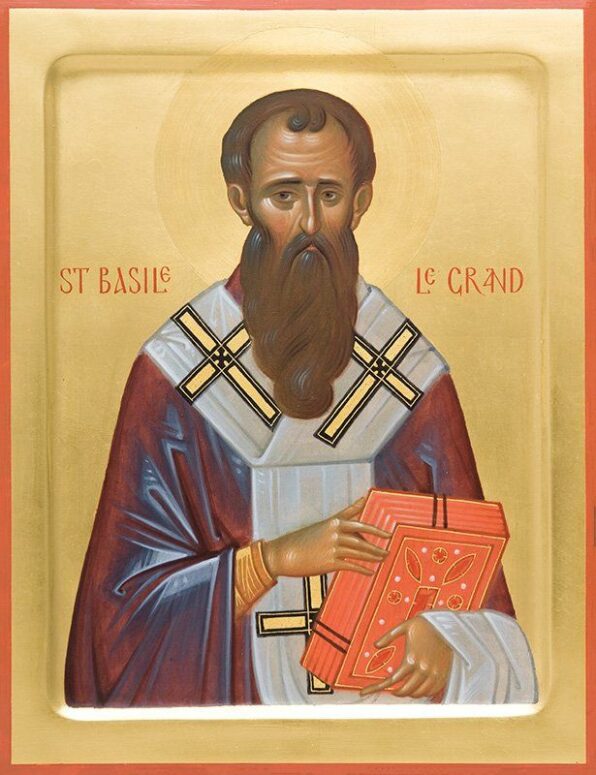
The Liturgy of St Basil the Great, currently served only 10 times a year, was once the most common. In the middle of the first millennium, it was revered as highly as the apostolic Liturgy. However, a number of questions have arisen over time, which need to be considered. Why did St Basil need to compile a new service? Are the texts that we have today really issued from St Basil’s pen? Did the saint compose a new text or edit an existing one?

Origin and Earliest Evidence
Saint Basil lived in the 4th century, but the first mention of the Liturgy composed by him dates back to the 6th century. According to Peter the Deacon, the Scythian monks, who arrived in Rome for the Theopaschite disputes in 519, quoted the anaphora of Basil the Great, claiming also that it was used almost throughout the entire East (The Book of the Incarnation and Grace). Around the same time, Leontius of Byzantium wrote in his essay titled Against the Nestorians and Eutychians that only two anaphoras existed in the Church. The first one was inherited from the apostles, and the second one, despite being written later by St Basil, retained the apostolic spirit.
Although the known direct references to the Liturgy of St Basil appeared only two centuries after his death, his contemporary and friend St Gregory of Nazianzus, in his funeral oration for Basil, mentioned the “liturgical rule of prayers” among his merits.
The Life of St Basil the Great, compiled around the 6th century, says that Basil asked the Lord to give him such wisdom that he could celebrate the liturgy, invoking the Holy Spirit in his own words. In all evidence, the reason for compiling his own anaphora was the fact that during the life of the saint there were no generally accepted written words for invoking the Holy Spirit. “Which of the saints has left us in writing the words of the invocation at the displaying of the bread of the Eucharist and the cup of blessing? For we are not, as is well known, content with what the apostle or the Gospel has recorded, but both in preface and conclusion we add other words as being of great importance to the validity of the ministry, and these we derive from unwritten teaching” (Basil the Great: On the Holy Spirit).
From the Life of St Basil we learn that besides compiling the anaphora, the saint also introduced external innovations corresponding to his perception of the Liturgy. For example, he hung a golden dove over the altar table as a tabernacle and erected an altar barrier .
Alternative Version of the Origin of the Anaphora and Related Issues
An alternative origin theory claims that St Basil was not the compiler, but the editor of the already established order, i. e. the liturgy of St James. The Apostolic Liturgy was too long and, because of the people’s weakness, St Basil shortened it. Later, St John Chrysostom did this once again for the same reason.
The degree of validity of this theory is difficult to determine. For one thing, because the text of the liturgy of St James, which the Church uses today, is a reconstruction. Today, it is only possible to compare the text of the liturgy of St Basil with separate fragments of the reconstructed text of the liturgy of St Jacob.
Determining the degree of relationship between the two services is also complicated by the fact that the texts of the liturgy and anaphora of St Basil were supplemented and edited many times. Two main versions of the anaphora text can be distinguished, an extensive and a short one. The first type is widespread in the Local Orthodox Churches and the Armenian Church, while the second one is common in the anti-Chalcedonian Churches in Africa. There are a number of questions regarding their origin.
Which text was written first? If St Basil only supplemented the existing rank, why does it bear his name? Why did the short version spread only in Africa? How did it happen that it superseded all other anaphoras there and remains the most common? There are no straight answers to these questions.
Authorship Issue
A large number of existing editions of the text beg the question: are the texts that we have now really compiled by St Basil? The answer is yes and no.
Indeed, St Basil used already existing texts in compiling his own liturgy. Indeed, later manuscripts were subject to editing and additions. However, all of them contain the basis, which, both in meaning and in exact formulations, echoes the works of St Basil. The characteristic literary language of the great Cappadocian is distinguishable from later inserts.
Jerome Engberding, a 20th-century Catholic liturgist, proposed a theory which may be a solution to the problem regarding the authorship of the liturgy of St Basil.
According to the researcher, the extensive versions of the text of the liturgy go back to one common text, conventionally designated as Ω. This text was originally written by the saint, although it contained elements of an older text, conventionally referred to as Ur. Further, the researcher suggested that a short version of the anaphora of St Basil does not actually belong to the saint, but is a Coptic redaction of the text Ur.
It is this theory and its subsequent interpretations that are predominant in contemporary historical liturgics.
Conclusion
St Basil compiled a new order of the liturgy, since before him there was no universally accepted full rite, while the existing individual prayers were recorded or transmitted verbally. St Basil used his own prayers, as well as those that already existed. The original text of the liturgy, compiled by the saint, has not survived. Of all its existing variants, the extensive rule, used in the Orthodox Churches is the closest to the original. Meanwhile, the most genuine part of the extant text is the anaphora.




